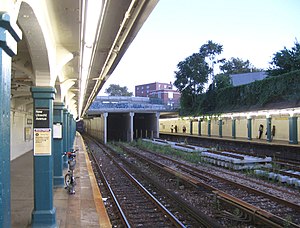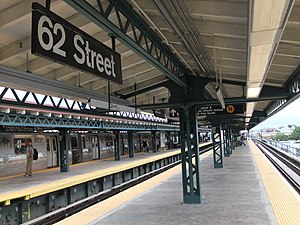62nd Street/New Utrecht Avenue station
New Utrecht Avenue/62nd Street | |||||||
|---|---|---|---|---|---|---|---|
 | |||||||
| Station statistics | |||||||
| Address | New Utrecht Avenue & 62nd Street Brooklyn, NY 11219 | ||||||
| Borough | Brooklyn | ||||||
| Locale | Bensonhurst, Borough Park | ||||||
| Division | B (BMT)[1] | ||||||
| Line | BMT Sea Beach Line BMT West End Line | ||||||
| Services | D N W | ||||||
| Transit | |||||||
| Levels | 2 | ||||||
| Traffic | |||||||
| 2023 | 1,201,167[2] | ||||||
| Rank | 257 out of 423[2] | ||||||
| |||||||
New Utrecht Avenue/62nd Street is a New York City Subway station complex shared by the open-cut BMT Sea Beach Line and the elevated BMT West End Line. It is located at New Utrecht Avenue and 62nd Street in Brooklyn, in the neighborhood of Bensonhurst, and is served by the D and N trains at all times.
Prior to the rebuilding of the two current subway lines at this location during the second decade of the 20th century, this location was known as Bath Junction. Until that time, there was a track connection between the lines, primarily to enable Sea Beach trains to and from Coney Island to access West End Line trackage to reach the Brooklyn Bridge and the Park Row elevated lines terminal in downtown Manhattan.
This entire station complex, along with eight other stations along the Sea Beach Line, is scheduled for a rehabilitation, which began in 2015 with 4 ADA-accessible elevators.[4]
History
Bath Junction was located near the present site of the station. It took the name as a railroad junction of the New York & Sea Beach Railway (Sea Beach Line) with the Brooklyn, Bath Coney Island Railroad (West End Line). The NY&SB called the station at the junction Bath Junction, while the BB&CI called it Sea Beach Junction. Soon, however, they settled on the common name. Bath Junction was located at grade near the current intersection of New Utrecht Avenue and 62nd Street.
The junction included a switching track connecting the two lines, so that NY&SB trains might reach the Brooklyn Bridge via the BB&CI tracks. Both lines merged with the BMT Culver Line at Ninth Avenue and later the BMT Fifth Avenue Line and BMT Myrtle Avenue Line.
After both lines were rebuilt as rapid transit lines of the Brooklyn Rapid Transit Company, the name Bath Junction was dropped. A connector was no longer necessary, as the West End Line was able to reach Manhattan on its own, and was not even realistic to plan, as one line dropped into a cut and the other became elevated. The multi-level station complex was created to allow passenger transfer between the two lines.
In 1985, this station had only 189 paying daily riders on a typical weekday in 1985 not counting farebeaters, making it one of the least used stations in the system.[5]
Station layout
| 2F Platform level |
Northbound local | ← |
| Peak-direction express | → No regular service (No service: Ninth Avenue (north) or Bay Parkway (south)) | |
| Southbound local | → | |
| 1F | Mezzanine | to entrances/exits, station agent, MetroCard vending machines |
| G | Street Level | Entrances/Exits |
| B1 Platform level |
Side platform, not in service | |
| Northbound local | ← No regular service () | |
| Northbound express | ← | |
| Southbound express | → No regular service | |
| Southbound local | → | |
| Side platform, doors will open on the right | ||
BMT Sea Beach Line platforms
New Utrecht Avenue | |||||||
|---|---|---|---|---|---|---|---|
 Eastern end of platforms | |||||||
| Station statistics | |||||||
| Division | B (BMT)[1] | ||||||
| Line | BMT Sea Beach Line | ||||||
| Services | N W | ||||||
| Structure | Open-cut | ||||||
| Platforms | 2 side platforms | ||||||
| Tracks | 4 (2 in regular service) | ||||||
| Other information | |||||||
| Opened | June 22, 1915[6] | ||||||
| Opposite- direction transfer | Yes | ||||||
| Traffic | |||||||
| 2023 | 1,201,167[2] | ||||||
| Rank | 257 out of 423[2] | ||||||
| Station succession | |||||||
| Next north | Template:NYCS next | ||||||
| Next south | Template:NYCS next | ||||||
| |||||||
New Utrecht Avenue Station (Dual System BRT) | |||||||
| MPS | New York City Subway System MPS | ||||||
| NRHP reference No. | 05000678[7] | ||||||
| Added to NRHP | July 6, 2005 | ||||||
| style="color:;background:#Template:NYCS color;text-align:center;padding:5px"| Track layout | |||||||||||||||||||||||||||||||||||||||||||||||||||||||||||||||
|---|---|---|---|---|---|---|---|---|---|---|---|---|---|---|---|---|---|---|---|---|---|---|---|---|---|---|---|---|---|---|---|---|---|---|---|---|---|---|---|---|---|---|---|---|---|---|---|---|---|---|---|---|---|---|---|---|---|---|---|---|---|---|---|
| |||||||||||||||||||||||||||||||||||||||||||||||||||||||||||||||

New Utrecht Avenue on the BMT Sea Beach Line has four tracks and two side platforms. Platform extensions are to the north end of the station and beyond the main staircase. Although most of the station is in an open cut, both ends of both platforms are underneath tunnels. The north end has two staircases to the full-time booth, where the transfer to the elevated BMT West End Line is available. The south end at 15th Avenue and 63rd Street is HEET access and formerly had a booth. The north end has unusual bricks on the staircase walls, suggesting the staircases were redone when the platform was extended. The original entrance had only one staircase to platform level. After the platform extension, the staircase was redone in a T formation along with the installation of brick walls. This segment of the station has been listed on the National Register of Historic Places since 2005.[8]
As part of a renovation project at nine stations along the Sea Beach Line, the Manhattan-bound platform at this station was closed on January 18, 2016, with an expected reopening in spring 2017.[9]
BMT West End Line platforms
62nd Street | |||||||
|---|---|---|---|---|---|---|---|
 | |||||||
| Station statistics | |||||||
| Division | B (BMT)[1] | ||||||
| Line | BMT West End Line | ||||||
| Services | D | ||||||
| Structure | Elevated | ||||||
| Platforms | 2 island platforms cross-platform interchange | ||||||
| Tracks | 3 (2 in regular service) | ||||||
| Other information | |||||||
| Opened | June 24, 1916 | ||||||
| Opposite- direction transfer | Yes | ||||||
| Traffic | |||||||
| 2023 | 1,201,167[2] | ||||||
| Rank | 257 out of 423[2] | ||||||
| Station succession | |||||||
| Next north | Template:NYCS next Template:NYCS next | ||||||
| Next south | Template:NYCS next Template:NYCS next | ||||||
| |||||||
| style="color:white;background:#Template:NYCS color;text-align:center;padding:5px"| Track layout | |||||||||||||||||||||||||||||||||||||||||||||||||||||||||||||||||||||||||||||||||||||||||||||||||||||||||
|---|---|---|---|---|---|---|---|---|---|---|---|---|---|---|---|---|---|---|---|---|---|---|---|---|---|---|---|---|---|---|---|---|---|---|---|---|---|---|---|---|---|---|---|---|---|---|---|---|---|---|---|---|---|---|---|---|---|---|---|---|---|---|---|---|---|---|---|---|---|---|---|---|---|---|---|---|---|---|---|---|---|---|---|---|---|---|---|---|---|---|---|---|---|---|---|---|---|---|---|---|---|---|---|---|---|
| |||||||||||||||||||||||||||||||||||||||||||||||||||||||||||||||||||||||||||||||||||||||||||||||||||||||||
62nd Street is an express station on the BMT West End Line that opened on June 24, 1916 as the terminal station of the first phase of the opening of the West End Line.[10][11]
The station has three tracks and two island platforms. The middle express track is only used for re-routings and non-revenue movements. There are two fare control areas. The full-time side is at 62nd Street (north end of station) and has the transfer to the BMT Sea Beach Line. The part-time side is at 60th Street (south end); it is where the famous chase scene in the 1971 film, The French Connection ends. This side was renovated and is HEET access for most of the day. A booth formerly existed here, but is now mostly empty space in the station house. New windows and lighting restored this mezzanine to good condition. However, the staircases from the street still have wooden boards. The station-house for the BMT Sea Beach Line used to have a newsstand and two additional doors on the left side. As of October 2010, this station was undergoing renovations, including two new far controls, new canopy and platform edges, and repainted side roof and beams; these were complete as of May 2012.
On the street, the northern station entrance is set back from New Utrecht Avenue. It is to the left when facing the Tomche Shabbos food pantry warehouse; there is a small, fenced-in overgrown area separating them, with a small MTA informational sign on the chain link. The station house is also visible from 62nd street, but there is a small MTA lot for separating street from station, designated for bus turnarounds, MTA maintenance, and MTA employee parking only. A staircase leads to the second floor of the station house, where one may use a covered, open-air passageway to reach the west end of the Sea Beach platform.
References
- ^ a b c "Glossary". Second Avenue Subway Supplemental Draft Environmental Impact Statement (SDEIS) (PDF). Vol. 1. Metropolitan Transportation Authority. March 4, 2003. pp. 1–2. Archived from the original (PDF) on February 26, 2021. Retrieved January 1, 2021.
- ^ a b c d e f "Annual Subway Ridership (2018–2023)". Metropolitan Transportation Authority. 2023. Retrieved April 20, 2024.
- ^ "Facts and Figures: Annual Subway Ridership". New York City Metropolitan Transportation Authority. Retrieved 2016-04-19.
- ^ "Two elevators coming to the N line during massive rehabilitation". October 4, 2013. Retrieved May 24, 2014.
- ^ Levine, Richard (1986-11-05). "COLUMN ONE: TRANSPORT". The New York Times. ISSN 0362-4331. Retrieved 2016-10-02.
- ^ "Through Tube to Coney, 48 Minutes: First Train on Fourth Avenue Route Beats West End Line Eleven Minutes". Brooklyn Daily Eagle. June 22, 1915. Retrieved 29 June 2015.
- ^ "NPS Focus". National Register of Historic Places. National Park Service. Retrieved December 9, 2011.
- ^ Kings County Listing at the National Register of Historic Places (Structure #05000678)
- ^ "N Line Sea Beach - 2016". web.mta.info. Retrieved 2016-01-18.
- "9 Brooklyn N train stations to shut down for 14 months". am New York. 2016-01-14. Retrieved 2016-01-18.
- Katinas, Paula (2014-12-18). "Commuter headache: MTA to renovate N train stations". Brooklyn Daily Eagle. Retrieved 2016-01-18.
- ^ "Realty Boom Is Predicted for Borough Park Section". Brooklyn Daily Eagle. June 24, 1916. Retrieved 16 September 2015.
- ^ "Parade, Pageant Mark Celebration: Borough Park Civic Bodies and School Children Join in Festivities: West End Line Opened: First Train From Manhattan Over New "L" Extension of Dual System to Sixty-Second Street". Brooklyn Daily Eagle. June 24, 1916. Retrieved 16 September 2015.
External links
- nycsubway.org – BMT Sea Beach Line: New Utrecht Avenue
- nycsubway.org – BMT West End Line: 62nd Street
- Station Reporter — 62nd Street/New Utrecht Avenue Complex
- The Subway Nut — New Utrecht Avenue Pictures
- 62nd Street entrance from Google Maps Street View
- 60th Street entrance from Google Maps Street View
- 15th Avenue entrance from Google Maps Street View
- Sea Beach Line platforms from Google Maps Street View
